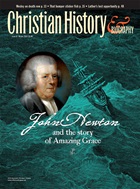Whose tomb is this, anyway?
A Jerusalem monument thought for millennia to be the tomb of King David's rebellious son, Absalom, may actually be the burial site of key Gospel figures, according to recently uncovered inscriptions from around A.D. 350. Joe Zias, a retired curator for the Israel Antiquities Authority, and Dead Sea Scrolls scholar Emile Puech discovered faded Greek writing only visible by sunlight at certain times of the day: "This is the Tomb of Zacharias, martyr, very pious priest, father of John." Nearby was a reference to Simeon, the Jewish priest who hailed Jesus as Messiah.
While the ascetic biblical scholar Jerome (c.345-420) recorded that Zacharias and Simeon were buried together, along with Jesus' disciple and brother James, most scholars say the finding tells us something about the beliefs of early Christians, but it's probably not the actual burial site. It probably wasn't Absalom's Tomb, either—archaeologists have dated the site to the first century B.C. "We don't know if it actually is Zacharias's tomb … but it is clear someone in the 4th century was convinced it was," University of South Florida religion professor Jim Strange told The Christian Science Monitor.
The find may prompt work on other neglected sites that will yield further insights. Absalom's Tomb itself had been of little archaeological or historical interest lately—Zias found it used at times as a drug den. Meanwhile, Zias is looking for an inscription mentioning James. "There are three burial niches, so it certainly fits," he says. But after the heated controversy over the last James find—the "son of Joseph, brother of Jesus" ossuary—he may be better off without it.
Bring me the thumb of George Whitefield
The archives at Drew University, in Madison, New Jersey, has the relics of many Methodist founders. Among them: Francis Asbury's glasses, upholstery from a chair that once supported John Wesley, and a peg that once held up Asbury's coat. The most shocking item is the thumb of evangelist George Whitefield (1714-1770), though no one knows how it got there. It's not the oddest thing about Whitefield's postmortem life, according to Bangor Seminary's Clifton Guthrie. In 1775, two Continental Army officers (one of them Benedict Arnold) reportedly stole the clerical collar and wristbands from Whitefield's corpse and carried them into battle. In 1829, his arm made a 20-year sojourn to Britain before returning to his Newburyport, Massachusetts, burial vault. Two thousand people joined the procession for its return.
Shining light on Rembrandt
Museumgoers may experience déjà vu upon viewing "Rembrandt's Journey: Painter, Draftsman, Etcher," an exhibit that includes more than 20 paintings, 35 drawings, and 150 prints. The collection emphasizes changes made by the Dutch painter (1606-1669) as he returned to a theme or subject. For example, notes the Associated Press, "In three prints—each from a different decade—depicting the presentation of the baby Jesus in the temple, Rembrandt progressively zooms in on the central subject, culminating in the 1654 version, when light and shadow dominate the print." Such variety "provides deeper insight into the inventive, subtle, and complex way he brought new life to traditional biblical themes and how he projected himself into them," says an exhibit press release. Other items include a rare print of "Christ Preaching" and an early sketch of "Christ Carrying the Cross," where a finger smudge guides viewers' eyes to the detailed faces of Christ and his mother. The exhibit, which also has a companion book, will be at the Art Institute of Chicago through May.
Petrarch uncovered
Italian scientists have exhumed 14th-century scholar Francesco Petrarch, considered the first modern poet. "This investigation could show something new about the poet and his personality," Claudio Bellinati, director of the historical archives of Padua, told Discovery News. "We will know what he looked like and we will be able to understand whether painful events, such as accidents and diseases, might have affected his life."
For example, tradition says that Petrarch fell from his horse. However, archeologists found his skeleton largely intact. Save, that is, for the missing right arm, messily swiped by a drunken monk about two and a half centuries after Petrarch's death. While Petrarch is today largely remembered for his romantic poetry (and then known for his hunger for fame and pagan knowledge), he also produced great Christian treatises, including essays on solitude and the contemplative life.
In the three volumes of Secretum (1342), he imagined Augustine of Hippo trying to convince him to reject the ways of flesh for eternal life. Augustine seems to have won out: Petrarch's last poetic work, Trionfi, is an allegory telling of the successive triumphs of Love, Chastity, Death, Fame, and Time—which is finally defeated by Divinity. The researchers hope to report their findings by July 20, Petrarch's 700th birthday.
Back to Bede
If you want to see how the father of English church history lived, don't go to his writings. The Venerable Bede (c. 673-735) left very little about himself. All he says is that in 680, at age 7, he was entrusted by his parents to a monastery at Jarrow, Northumbria, and "spent all the remainder of my life in this monastery and devoted myself entirely to the study of the Scriptures." But today, a British museum has brought the historian's world to life. At Bede's World (www.bedesworld.co.uk), on the site of his monastery, visitors can see the life of a monastery recreated in buildings, archeological finds, and a working farm. Interpreters demonstrate the arduous way such crafts as silversmithing and calligraphy were done 1,300 years ago. The disciplines of medieval faith may also be tasted at many contemporary monasteries in the U.K. that offer contemplative retreats for the modern Christian.
Engraven images
It's called the Word of God, but artists and evangelists have long sought to add images to the text of the Bible. Among the more notable examples are the famous woodcuts of Gustave Doré (1832-1883) and A Curious Hieroglyphick Bible, published by American printer Isaiah Thomas in 1788 for children (only four copies remain). Now other artists are taking up the approach of these two men. Barry Moser spent four years on his Pennyroyal Caxton Bible, which contains 232 fine engravings that many critics say surpass Doré's famous work. "Doré didn't bother with four of the five books of poetry," admits Moser. Initially intended for only 400 handprinted copies, Moser's Bible was published in a 2002 paperback edition by Viking Press. More closely following Thomas's approach is Patrick Hembrecht, the artist running the Flaming Fire Illustrated Bible project (www.flamingfire. com/bible.html). The multiple-artist effort, launched in 2002, hopes to illustrate all 36,665 verses of the King James Bible—and has about 35,000 to go. "I love reading the Bible and talking about it," he told Religion News Service. "And I wanted to do it in a way that seemed like sharing and not like I was being preachy."
Librarian, don't throw away that old box!
That final scene from Raiders of the Lost Ark, where the relic is packed in a box and filed away, never to be seen again, may not be too far from the truth. Just ask George Stewart, the retired director of the Birmingham (Ala.) Public Library. Since the 1940s and 1950s, boxes containing as many as 10,000 books donated to the state archives have sat unopened, uncatalogued, unrecorded, and unused. Three years ago, the bibliophile's equivalent of Christmas came, and he began opening the boxes. Among the treasures inside: a four-centuries-old copy of the Geneva Bible. First published in 1560, with more than 200 editions over the following years, the Geneva Bible, widely popular in Britain, was produced by staunch Protestants and was the first English Bible to include verse numeration. Alabama's edition is from 1611, a year marking the Geneva Bible's eclipse with the publication of the King James Version. "It is a treasure that was neglected," Stewart told The Birmingham News. "It's not anybody's fault. It's just that [archives officials] never had money to have the staff to do it."
El Greco's echo
Religious painter and sculptor El Greco, less well-known as Domenicos Theotocopoulos (1541-1614), had many fans and followers among later artists, including Paul Cézanne, Pablo Picasso, Henri Matisse, and Jackson Pollock. This year, he's gaining even more admirers as a major retrospective of his work travels from New York's Metropolitan Museum of Art to London's National Gallery. "El Greco's religious paintings are really about the world of the imagination," curator Keith Christiansen told the Associated Press. But, he added, "you feel that the artist is in touch with the world of everyday experience."
Reviewers were particularly struck by the contrast between the portrait of a cardinal inquisitor (probably Cardinal Niño de Guevara), and a young monk/preacher, Fray Hortensio Félix Paravicino. The former's "mirthless eyes scan through rimmed glasses to another part of the room. He's not looking at you, but you know he sees you," wrote Commonweal's Patrick Jordan. The latter, meanwhile, is painted to represent "what was best in seventeenth-century Spanish Catholicism: intelligence, purity, and mystical awareness marshaled in service of the good." The 80 or so pieces constitute the first major U.S. El Greco exhibit in two decades, and the first ever in the U.K. Those who miss it can still find the virtual version of the exhibit online at the two museums' web sites or in the companion book published by Yale University Press.
Copyright © 2004 by the author or Christianity Today/Christian History & Biography magazine.
Click here for reprint information on Christian History & Biography.

Support Our Work
Subscribe to CT for less than $4.25/month





























